
|
|
|
The Genealogical Research Division of

|
|
|
|
Latvia: Finding Your Ancestor’s Town of Origin
|
Most people researching their Latvian Jewish roots are the descendants of immigrants who braved the unknown to leave their home country and pursue a new life in the United States, Canada, the United Kingdom, Israel, South Africa, Argentina or elsewhere. Before going overseas to examine our roots, we first need to examine our immigrant ancestors and find out all we can about them and their extended families. In doing so, the researcher must learn about names and naming, immigration and naturalization records, and Latvian geography and history.
Much has already been written on names, both personal and the adoption and formats of Jewish surnames. Latvia became part of the Russian Empire in 1795, and as such, most of the official overseas documents that are relevant to family research will reflect Russian spelling. Jewish personal and surnames were translated to Russian equivalents according to their sound, so spelling was not consistent. When Latvia became independent after World War I, records reflect the Latvian forms of surnames. When looking at immigration records, especially ship manifests, the researcher needs to know both the original surname and the first name (typically in Yiddish) of the immigrant ancestor. Not every immigrant changed his or her name, and if it was changed, it was not changed by officials at Ellis Island. 1 The original surname may be the subject of family lore, and aside from the Ellis Island myth, may likely be true. Occasionally the original surname may be found on a naturalization record. Warren Blatt presented an excellent talk on Jewish Given Names and their variations. The classic work on the origins of Russian Jewish surnames is Alexander Beider’s reference book on the topic. 2 Jeffrey Mark Paull and Jeffrey Briskman have also written an interesting background article on the adoption of Jewish surnames in the Russian Empire.
In order to distinguish your ancestor from others with the same or similar name, it is helpful to know the given names of the immigrant ancestor’s parents. Possible sources: are marriage records, gravestones (older stones show the Hebrew name of the father), U.S. Social Security applications (SS-5 form), and death certificates. Documents filled out by the immigrant themselves are generally more reliable that those completed by descendants (e.g., death certificate informants), who may not have known the ancestor’s parents personally. Name changes that took place in Israel during the British mandate period are described below.
While some families immigrated together, it was common for younger relatives to strike out on their own and immigrate as individuals, sometimes joining an older relative who had already made the journey. When researching the history of your family, be prepared to look for both individuals and families. People left for many reasons, some economic, some personal, some fleeing the draft or persecution. It was common for a father to leave his family behind while he got established in his new country, sending for his family some years later. The first task in researching an ancestor’s family is to learn about their immigration story in order to identify where they lived before they immigrated. There are multiple record types that can give clues about the immigrant’s place of origin. The trick is to find a source that is specific and not just a reference to the generic “Russia.” The categories of records which may be helpful include immigration records (ship manifest and border crossings), naturalization records, and passports. Note that not all immigrants naturalized in the country where they settled. In general, later records give more specific information than earlier ones. The earliest ship records point only to the country of origin. For U.S. naturalization information, pre-1906 certificates are not generally useful. Other possible sources of immigrant origin information include some vital records (birth, marriage, and death), identity cards, and family photographs.
Note that the documents under discussion may not always be accurate. People were not always knowledgeable about their birthdate or exact birthplace, depending on what they had been told by their families. Often immigrants gave the name of the closest big city, rather than the small shtetl where they were actually born or lived. The reliability of death records for parents’ birthplaces depends on the knowledge of the informant, which is sometimes lacking. Conversely, parents are likely to know the birthplace of their children, whose names and birth places may be listed in naturalization documents.
If there is no information about a specific ancestor, research collateral relatives who immigrated (parents, siblings, aunts and uncles, etc.). It is good practice to research the entire immigrant family, as records may exist for some members and not for others. By researching the entire family, it is possible to create a tentative picture of the family’s origins.
Vital records (birth, marriage, and death) vary greatly, based on jurisdiction. They are maintained by a number of different levels of government — municipal, state or province, or even country. Some contain specific information on the ancestor’s (or their parents’) birthplaces, while others only contain the country of origin. Availability of vital records depends entirely on location, both in terms of coverage and access laws. Some agencies have made great strides in digitizing records, while others have not, so records may need to be ordered online, via mail or even viewed onsite. Genealogy databases such as FamilySearch.org, Ancestry.com ($), and MyHeritage.com ($) have also obtained both indexes and digitized copies of many vital records.
Vital records access is covered in a number of general genealogical “how-to” videos, and online or printed sources. The FamilySearch Wiki can be especially helpful, as it details information about vital records access by geographical location. Because of the wide variation of records and means of access, the beginning researcher should consult general genealogical sources to learn about the availability and contents of vital records for the areas where their ancestors settled. This discussion will focus on immigration and citizenship resources that may identify the town of origin, divided by the countries listed below.
Prior to 1891, U.S. passenger lists did not give much information on immigrant passengers. After 1891, the U.S. Bureau of Immigration was created to handle immigration affairs, and steamship companies were required to complete the manifests at the port of embarkation. Over time, responsibility for immigration shifted to other government agencies, and steamship manifests collected more details about new immigrants. Depending on year of the manifest, there will be columns for the “Last permanent residence” and “Place of birth.” Later manifests include the name and address of the nearest relative or friend in country of origin. This information was also collected at border crossings between the U.S. and Canada. Whether looking at a ship manifest or border crossing record, be sure to check for a page 2, which often has additional valuable information. If the immigrant sailed from Hamburg, there will be a German emigration manifest in addition to the American immigration manifest.
In most cases, immigrants arrived in the U.S. under their “old country” names. The exception might be if an immigrant lived in an intermediate country for some period of time (e.g., U.K. or Ireland) and changed their name prior to boarding the ship to America. The spelling of the immigrant’s name depends on the way it sounded to the recording clerk, and may vary according to the jurisdiction under which they sailed. Spelling of names was imprecise, so the researcher needs to be creative!
One useful video which will help in your search are Finding Your Immigrant Ancestors, by Crista Cowan on the Ancestry.com YouTube channel.
U.S. ship manifests and indexes are available on a variety of websites, some free and some subscription. Ancestors coming in through Boston, Baltimore, Philadelphia, or other ports will not show up on the Ellis Island website.

If you can’t find your ancestor’s ship record, it may be mis-transcribed. In that case, there may be a clue to the ship record in the ancestor’s naturalization record, if the ancestor naturalized. Note that ancestors often did not remember their exact date of arrival in their naturalization petitions, but the ship name is usually correct, and through creative searching, the manifest can often be located.
A good overview of U.S. Naturalization records may be found on the FamilySearch Wiki and on the National Archives and Records Administration (NARA) website.
U.S. naturalization records may be found at the following sites:
This is a partial sample of a U.S. naturalization record showing the immigrant’s birthplace as Ribeny, Latvia (present-day Riebini):
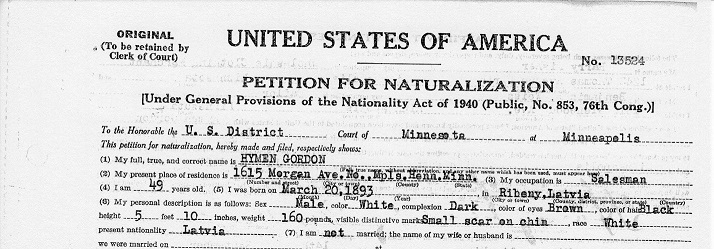
Males in the United States had to register for the draft for both World Wars. This included the so-called “Old Man’s Draft,” of World War II, which covered men too old to fight, born between 27 April 1877 and 16 February 1890, who may have had skills to contribute to the military effort. The World War I draft registration cards generally only give the country of birth, but the World War II documents give specific locations.
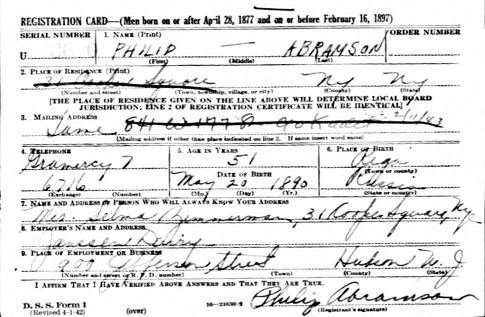
Before searching for ancestors on Canadian ship manifests, search for the ancestor’s name in indexes for U.S. manifests. Some immigrant ancestors settled initially in the U.S., and then moved to Canada at a later date, so there is a chance that the information may show up on a U.S. manifest that may have more information that a Canadian counterpart. Canadian ship manifests, prior to the implementation of form 30A in 1919, only list country of origin. Form 30A and manifests after 1924 list town name and the address of closest relative in country of origin.
Library and Archives Canada’s naturalization records include two collections of interest:
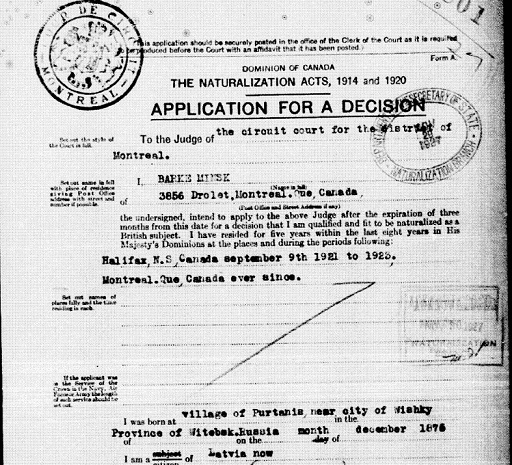
The Library and Archives Canada collection “Immigrants from the Russian Empire, 1898-1922” contains personal documents that immigrants brought with them to Canada. Immigrants surrendered these records to the consular officials in return for the required identity cards that would let them to work and live in Canada. The documents are digitized. Although file documents are mostly in Russian, the place of origin of the immigrant (e.g.: Varakļāni, Rezhitsa uyezd, Vitebsk gubernia) is clearly visible on the cover of the folder.
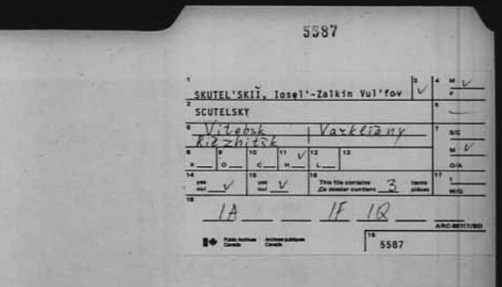
Records from the National Registration File of 1940 may be ordered from Statistics Canada. These files were required to be completed during World War II by all non-military residents of Canada. Among other things, they include information on the birthplace of the individual and his or her parents. The address of the subject in 1940 is required, and may be found either from Canadian voter registration lists on Ancestry.com ($) or from city directories (variable sources).
The inbound ship records from the European continent to British ports were not preserved. Occasionally, on some outbound UK ship records, there may be reference to the ship and country of origin of the inbound ship when the immigrant was using the UK as a transit point, but there is no information to pinpoint the immigrant’s exact origin. Ancestry’s collection, “UK, Outward Passenger Lists, 1890-1960,” can nonetheless be very useful to immigration researchers whose ancestors left the UK. The UK outbound manifests do not provide much detail, but can still be helpful in tracking ancestors who do not show up on U.S. or Canadian ship searches. Sometimes transcription errors can make these ancestors untraceable. If the researcher can verify the ship name, departure date and destination on the UK outbound passenger list, it easy to search for the ship on the U.S. or Canadian inbound side, using only the information about the ship itself. The manifests can be located by ship name and date on any of the websites above; for Canadian ships they can be found for free on the Library and Archives Canada website. A comparable collection, “Passenger Lists Leaving UK 1890-1960,” may be found on Findmypast.com ($).
The Central Zionist Archives is the best place to begin research on immigrants to Israel.
Naturalization files for immigrants who naturalized during the British Mandate may be found online at the National Archives of Israel.
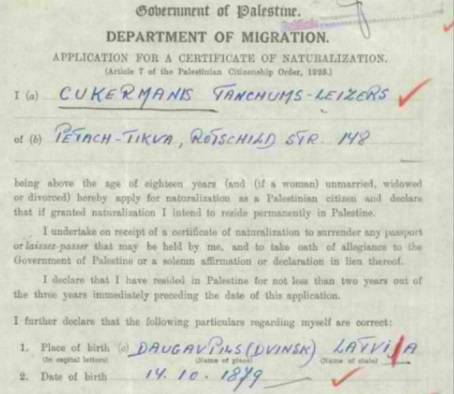
The Montefiore Censuses, which include place of origin, are a good source of information about 19th-century immigrants to Israel. However, surnames of Ashkenazi Jews are often not included.
The Israel Genealogy Research Association (IGRA) has a variety of databases that may also have information about the origins of your ancestors. Database access requires membership (nominal fee).

Ship manifests for South African arrivals have generally not been preserved, but there are other resources that may list immigrant towns of origin.

This is an example of a South African Jewish Board of Deputies arrival list, found on the above index; the copy was obtained from the archives at the University of Cape Town:

An index to South African naturalization records from 1840 to 1910 may be found at the website of the National Archives of South Africa. Depending on the province, these records usually list place of birth.
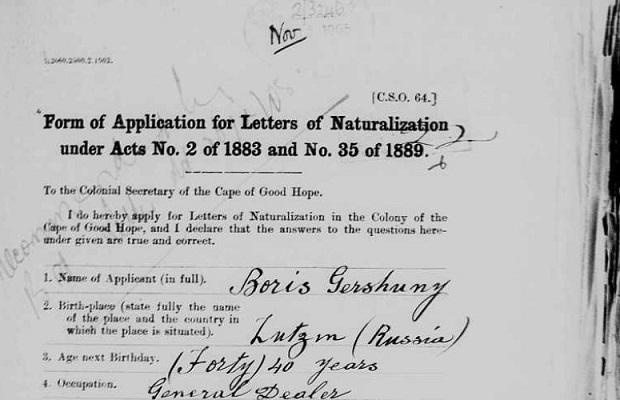
Immigrants leaving Hamburg for Argentina are included in Ancestry.com’s collection, “Hamburg Passenger Lists, 1850-1934.” Note that the immigrant’s name may be spelled according to German spelling rules, e.g., Leah Minsk will be Leja Minsk.
There is a partial unindexed collection of inbound ship manifests to Argentina on the FamilySearch.org website, but it does not appear to give precise places of birth or previous residency.
If you are lucky enough to have a copy of your ancestor’s Carta de Ciudadanía, it will show his or her birthplace.
Since jurisdictions and languages changed over times, most Latvian towns were known by three or four town names, variants in German, Russian, Latvian, and Yiddish. Most 19th-century archival documents from Latvia are in the Russian language, and researchers should be aware that there is no “H” in the Russian language, and a “G” was substituted. This happened both in personal names (i.e.: "Hirsch" became "Girsch") and town names ("Hasenpoth" --> "Gasenpoth"). Due to transliteration differences, a “V” and “W” can also be interchangeable.
For assistance in deciphering town names, the JewishGen Communities Database can be very helpful.

After finding the town name, the researcher should learn about the town, district and province during various time periods. Maps, both contemporary and historical, can be used to find nearby towns and learn about the area where an ancestor lived. Ancestors did not always spend their lives in one place. They may have married someone from another town, or given birth in a different town. Business was often transacted elsewhere, and some people relocated to other communities. “Your” town may not have records, but a nearby town might!
There are profiles of several Latvian towns in JewishGen’s KehilaLinks. In addition, the JewishGen Yizkor Book Project website has translations for a number of Latvian towns that are included in Dov Levin’s Pinkas Ha-Kehilot Latvia v’Estonia.
Marian L. Smith, 'American Names: Declaring Independence', Immigration Daily (https://www.ilw.com/articles/2005,0808-smith.shtm: viewed 29 Jun 2015). Marian L. Smith is the senior historian at U.S. Citizenship and Immigration Services, Department of Homeland Security, and a frequent speaker and author regarding immigrant research. This is one of many articles debunking the name change at Ellis Island myth. (return to text)
Alexander Beider, A Dictionary of Jewish Surnames from the Russian Empire, revised ed. (Bergenfield, NJ: Avotaynu, 2008). This is an expensive book, but is often held by various Jewish genealogical societies in their reference library. (return to text)
| JewishGen InfoFile Index | JewishGen Home Page |

|
Edmond J. Safra Plaza | 36 Battery Place | 646.494.2972 | info@jewishgen.org | |

|